Questões de Vestibular
Foram encontradas 69.665 questões
Resolva questões gratuitamente!
Junte-se a mais de 4 milhões de concurseiros!
ASSAF NETO, A.; LIMA, F. G. Fundamentos de Administração Financeira. 3. ed. São Paulo: GEN Atlas, 2017 (adaptado).
Para um projeto com valor do investimento no momento inicial (I0) de R$ 1 000,00 e valor presente dos benefícios futuros de R$ 910,00 tem-se que o VPL é de
ASSAF NETO, A.; LIMA, F. Curso de administração financeira. 4. ed. São Paulo: GEN Atlas, 2019 (adaptado).
Considerando as informações apresentadas, avalie as afirmações a seguir, sob o ponto de vista do custo de capital.
PADOVEZE, C. L. Controladoria Estratégica e Operacional. 3. ed. São Paulo: Cengage Learning, 2013 (adaptado).
Com base nas informações apresentadas, avalie as afirmações a seguir.
I. Matéria-prima, mão de obra direta, mão de obra indireta, custos gerais industriais e depreciação das máquinas da produção são gastos considerados para a determinação do custo unitário de um produto, considerando o método de custeio por absorção.
II. Matéria-prima e mão de obra direta são gastos considerados para a determinação do custo unitário de um produto, considerando o método de custeio direto/variável.
III. Matéria-prima, mão de obra direta, mão de obra indireta, mão de obra administrativa/ comercial, custos gerais industriais e depreciação das máquinas da produção são gastos considerados para a determinação do custo unitário de um produto, considerando o método de custeio por absorção.
É correto o que se afirma em
Aplicando a taxa de atratividade aos fluxos incrementais, eles passariam a R$ 18 181,00, R$ 4 132,00, R$ 7 513,00 e R$ 13 660,00, conforme demonstrado na figura a seguir.

Com base nas informações apresentadas e considerando apenas os números inteiros, selecione a alternativa correta.
ASSAF NETO, A. Mercado Financeiro. 15. ed. São Paulo: GEN Atlas, 2021 (adaptado).
Com base nas afirmações do texto, avalie as afirmações a seguir.
I. O financiamento de capital de giro, realizado por bancos comerciais/múltiplos e bancos de investimentos, visa suprir as necessidades de recursos do ativo circulante (capital de giro) das empresas.
II. As operações de repasse constituem-se em empréstimos contratados por instituições financeiras do mercado de capitais e repassados a empresas carentes de recursos para investimentos de longo prazo.
III. As debêntures são títulos de dívida de curto prazo emitidas por sociedades LTDA e destinadas, geralmente, ao financiamento de projetos de investimentos ou para alongamento do perfil de endividamento das empresas.
IV. A caderneta de poupança é considerada a modalidade de aplicação financeira mais tradicional no Brasil, classificada como conservadora por oferecer baixo risco e, também, menor retorno, principalmente se comparada a outros tipos de aplicações financeiras.
É correto apenas o que se afirma em
Um empresário aplicou R$ 5 000 durante 3 anos à taxa de 20% a.a. e obteve os seguintes rendimentos e montantes.
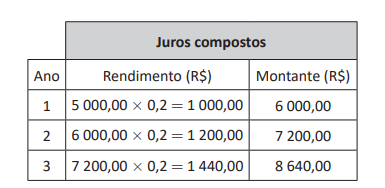
Com base nas informações apresentadas, avalie as afirmações a seguir.
I. O rendimento total dessa aplicação, considerando os três anos, foi de R$ 3 640,00, e o ano 3 teve R$ 1 440,00 de juros.
II. Em quatro anos de aplicação, o montante seria de R$ 9 200,00 e o rendimento total, considerando o mesmo período, seria de R$ 5 368,00.
III. Em cinco anos de aplicação, o montante seria de R$ 12 441,60 e o rendimento total, considerando esse período, seria de R$ 7 441,60.
É correto o que se afirma em
Disponível em: http://www.contabeis.com.br/artigos/3261/os-principais-indicadores-de-investimento-da-analise-financeira/. Acesso em: 5 jul. 2022 (adaptado).
A tabela a seguir evidencia os indicadores econômicos e financeiros de uma empresa.
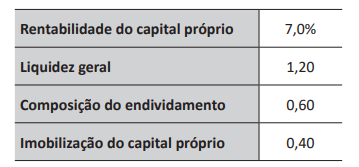
Com base nas informações apresentadas, avalie as afirmações a seguir.
I. O índice de rentabilidade do capital próprio indica o quanto rende o capital médio aplicado na empresa pelos proprietários.
II. O índice de liquidez geral significa que a empresa possui bens e direitos suficientes para liquidar os compromissos financeiros a curto prazo.
III. O índice composição de endividamento indica que 60% da dívida da empresa vence a curto prazo.
IV. O índice imobilização do capital próprio significa que 40% dos recursos próprios estão investidos em ativos de natureza permanentes.
É correto apenas o que se afirma em
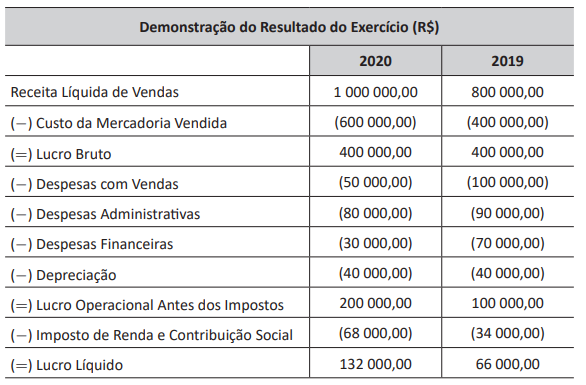
Com base nos dados apresentados, avalie as afirmações abaixo.
I. A margem bruta de 2020 foi superior à margem bruta de 2019.
II. A margem líquida de 2020 foi superior à margem líquida de 2019.
III. O EBITDA (lucro antes dos juros, impostos, depreciação e amortização) do ano de 2020 foi superior ao EBITDA de 2019.
É correto o que se afirma em
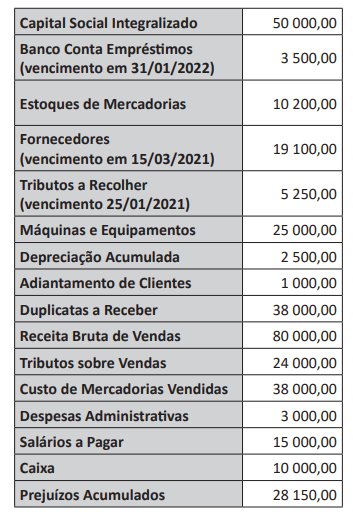
Com base nas informações apresentadas, o valor do passivo circulante é de
Problemas públicos e políticas públicas existem nas áreas de educação, segurança, saúde, gestão pública, meio ambiente, saneamento, habitação, emprego e renda, previdência social, planejamento urbano, entre muitas outras áreas. A finalidade de uma política pública é o enfrentamento, diminuição e até mesmo a resolução do problema público.
SECCHI, L. Análise de políticas públicas: diagnóstico de problemas, recomendação de soluções. São Paulo: Cengage Leaning, 2016
TEXTO 2
Considera-se que políticas de governo são aquelas que o Executivo decide em um processo elementar de formulação e implementação de determinadas medidas e programas, visando responder às demandas da agenda política interna, ainda que envolvam escolhas complexas. Já as políticas de Estado são aquelas que envolvem mais de uma agência do Estado, passando em geral pelo Parlamento ou por instâncias diversas de discussão, resultando em mudanças de outras normas ou disposições preexistentes, com incidência em setores mais amplos da sociedade.
OLIVEIRA, D. A. Das políticas de governo à política de Estado: reflexões sobre a atual agenda educacional brasileira. Educ. Soc., Campinas, v. 32, n. 115, p. 323-337, abr.-jun. 2011.
Considerando os tipos de políticas públicas apresentadas nos textos, avalie as afirmações a seguir.
I. Políticas públicas podem ser formuladas por iniciativa do poder executivo ou do legislativo, separada ou conjuntamente, a partir de demandas e propostas da sociedade, em suas diversas representações.
II. Políticas públicas envolvem conflitos de interesse e resultam de uma complexa interação que envolve o Estado, o governo, a iniciativa privada e diversas organizações da sociedade civil.
III. Políticas de governo são aquelas que geralmente estão previstas em lei e independem do governo e do governante para serem executadas, pois as boas políticas permanecem inalteradas.
IV. Políticas de Estado são aquelas que têm menor durabilidade, com institucionalização mais fraca, dependem da alternância de poder, pois cada governo transforma seu programa em políticas públicas, que serão executadas ao longo do mandato.
É correto o que se afirma em
O Fundo Partidário foi criado pela Lei n. 4.740/1975. A Lei n. 9.096/1999, que regulamentou o fundo, permite custear despesas cotidianas das legendas, como contas de luz, água, aluguel, passagens aéreas e salários de funcionários, entre outras. Em 2019, com a aprovação da minirreforma eleitoral, passou a ser permitido o uso do Fundo Partidário para o impulso de conteúdo na internet, compra de passagens aéreas para não filiados e a contratação de advogados e contadores. A fonte do Fundo Eleitoral é formada por dotações orçamentárias da União, multas e penalidades pecuniárias de natureza eleitoral, doações de pessoas físicas depositadas diretamente nas contas dos partidos (abertas especificamente para o Fundo) e outros recursos que eventualmente forem atribuídos por lei. Conforme a regra, 5% do montante do Fundo Partidário se distribui igualmente entre todos os partidos legalmente registrados. O restante, 95%, é dividido proporcionalmente, de acordo com o número de deputados que cada partido tem na Câmara dos Deputados.
Disponível em: https://www.tse.jus.br/imprensa/noticias-tse/2021/Novembro/fundo-eleitoral-x-fundopartidario-entenda-a-diferenca. Acesso em: 15 jun. 2022 (adaptado).
Considerando o texto apresentado, avalie as afirmações a seguir.
I. A forma de distribuição do Fundo Partidário favorece os partidos que já contam com deputados eleitos para a Câmara dos Deputados.
II. Os recursos do Fundo Partidário não podem ser utilizados quando o partido incorre em despesas com mídias digitais.
III. As fontes do Fundo Eleitoral são oriundas de recursos públicos e privados.
IV. O Fundo Eleitoral compartilha responsabilidades do Estado e da sociedade civil, na sua forma de financiamento.
É correto apenas o que se afirma em
Considerando essa realidade, avalie as afirmações a seguir.
I. O orçamento participativo é um espaço aberto aos cidadãos no processo de tomada de decisão pública, permitindo-lhes analisar e opinar sobre a aplicação dos recursos públicos e controlar as prestações de contas.
II. O Ministério Público, Tribunais de Contas e Controladoria Geral da União são órgãos institucionais de controle interno e externo que executam ações em prol da coletividade.
III. A audiência pública está relacionada ao espaço institucional voltado àqueles que tenham interesse, que podem ser afetados por ações governamentais, expressando sua opinião sobre as questões ali discutidas de forma a participarem do processo decisório.
IV. A accountability horizontal ocorre quando os cidadãos controlam os políticos e governos por meio de plebiscito, referendo e voto, ou mediante o exercício do controle social e o accountability vertical, quando há uma relação entre iguais, por meio de mecanismos de checks and balances, da mútua vigilância entre os três poderes autônomos do Estado.
É correto apenas o que se afirma em
Considerando o texto, avalie as afirmações a seguir.
I. A viabilização de projetos sociais depende da mobilização social e dos recursos previstos na Lei de Responsabilidade Fiscal.
II. A LOA passou a ser baseada em um planejamento estabelecido anteriormente no PPA e também em um planejamento fiscal normatizado pela LDO.
III. Os prazos dados pela Constituição Estadual e a Lei Orgânica dos Municípios para a elaboração do PPA são sempre anuais para a LDO e a LOA e, em relação ao chefe do Executivo, em seu primeiro ano de mandato.
IV. Nas ações de políticas públicas, participam funcionários públicos e burocratas que escolhem, entre os modelos de implementação de políticas, a gestão do tipo top-down ou bottom-up.
É correto apenas o que se afirma em
Considerando o contexto apresentado, avalie as afirmações a seguir.
I. Os estados que apresentarem mais pessoas na faixa etária de 18 anos irão imunizar mais rapidamente seus cidadãos.
II. A distribuição ajustada das doses garantirá maior heterogeneidade na vacinação em todas as unidades da Federação.
III. A metodologia apresentada permitirá equiparar a vacinação, por faixa etária, em todos os estados e Distrito Federal.
IV. O tipo de metodologia apresentado obedece ao princípio maior, que rege toda a gestão do Sistema Único de Saúde (SUS), que se chama economicidade e universalidade.
É correto o que se afirma em
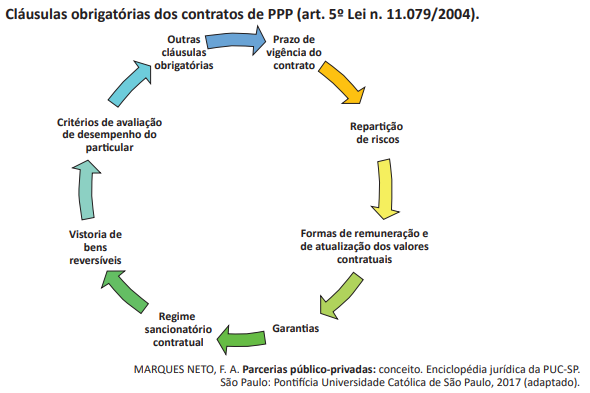
Sobre as cláusulas obrigatórias em um contrato de Parceria Público Privada (PPP), avalie as afirmações a seguir.
I. O contrato de PPP tem prazo de vigência indeterminado, considerando a qualidade do serviço prestado.
II. A matriz de risco leva em consideração a capacidade de gerenciamento dos riscos para cada uma das partes em relação a cada risco específico.
III. O contrato deverá prever hipóteses de inadimplência do Poder Público, bem como prazo de regularização, acionamento das garantias e penalidades aplicáveis à Administração Pública.
IV. O contrato de PPP deve definir previamente quais bens serão reversíveis ao término da concessão com vistoria a ser feita ao final da concessão ou ao longo da execução contratual.
É correto o que se afirma em
Considerando necessária a comprovação da participação de engenheiro químico indicado pela empresa licitante, como responsável técnico, nos serviços elencados no atestado apresentado pela empresa na licitação. Considerando que a empresa licitante trouxera documentação nova visando a essa comprovação, com data de emissão posterior à abertura do certame. Considerando o seguinte dispositivo da nova Lei de Licitações (Lei n. 14.133/2021): “Art. 64. Após a entrega dos documentos para habilitação, não será permitida a substituição ou a apresentação de novos documentos,salvo em sede de diligência, para: I- complementação de informações acerca dos documentos já apresentados pelos licitantes desde que necessária para apurar fatos existentes à época da abertura do certame; II - atualização de documentos cuja validade tenha expirado após a data de recebimento das propostas”. Decide-se: recomendar a INABILITAÇÃO da empresa na licitação.
Considerando essas informações, avalie as asserções a seguir e a relação proposta entre elas.
I. A decisão do parecer técnico que considerou a apresentação de nova documentação em desacordo com o art. 64 da Lei n. 14.133/2021 está correta.
PORQUE
II. A vedação à inclusão de novo documento, prevista no art. 64 da nova Lei de Licitações (Lei n. 14.133/2021), não alcança documento ausente comprobatório de condição atendida pelo licitante quando apresentou sua proposta, que não foi juntado com os demais comprovantes de habilitação e/ou da proposta.
A respeito dessas asserções, assinale a opção correta.
O teto de gastos é um entre muitos tipos de regras fiscais. A regra do teto de gastos também substituiu o hábito de se propor punição ao gestor público, quase sempre não-crível, por medidas automáticas de ajustamento: os chamados “gatilhos”. A ideia era que, sempre que a despesa crescesse além do limite, automaticamente, uma série de rubricas de caráter obrigatório ficaria congelada ou não teria aumento acima da inflação. Novas despesas obrigatórias também não poderiam ser criadas.
Disponível em: https://www.insper.edu.br/wp-content/uploads/2021/09/Regras-fiscais-e-o-caso-do-teto-de-gastosno-Brasil-2021_Marcos-Mendes.pdf. Acesso em: 27 jun. 2022 (adaptado).
TEXTO 2
Os dirigentes de universidades federais afirmaram em audiência na Comissão de Educação da Câmara dos Deputados que, sem contar a variação da inflação, falta cerca de R$ 1 bilhão no Orçamento de 2022 dessas instituições para que elas consigam pelo menos o que foi gasto em 2019, antes da pandemia, em um total de R$ 6,2 bilhões. O Governo Federal anunciou que o corte nas despesas discricionárias das universidades previsto para 2022 é de 7,2%.
Disponível em: https://www.camara.leg.br/noticias/883945-universidades-federais-alertam-que-orcamento-emenor-do-que-antes-da-pandemia/. Acesso em: 27 jun. 2022 (adaptado).
Considerando a situação de contingenciamento orçamentário apresentada, os (as) reitores(as) de universidades podem tomar como possível(is) medida(s)
Considerando o texto, avalie as afirmações a seguir.
I. A receita disponível para cada esfera de governo, isto é, a receita bruta arrecadada após a dedução das transferências constitucionais, fica em maior parte com o governo federal e em menor com os municípios.
II. A descentralização das políticas públicas, que ocorreu após a Constituição Federal de 1988, trouxe para os governos locais, ou seja, os municípios, grande responsabilidade pela provisão de serviços essenciais à população, tais como acesso aos serviços de saúde e educação básica, sendo que parte destes serviços é financiada por meio de transferências intergovernamentais, especialmente advindas da União.
III. Os bens e serviços públicos, tais como defesa nacional e políticas de distribuição de renda, tornam-se mais eficientes e efetivos se forem prestados pelos governos locais, isto é, pelos municípios, os quais possuem melhor capacidade de identificação das preferências dos cidadãos do que o governo central, devido à proximidade com esses sujeitos.
É correto o que se afirma em
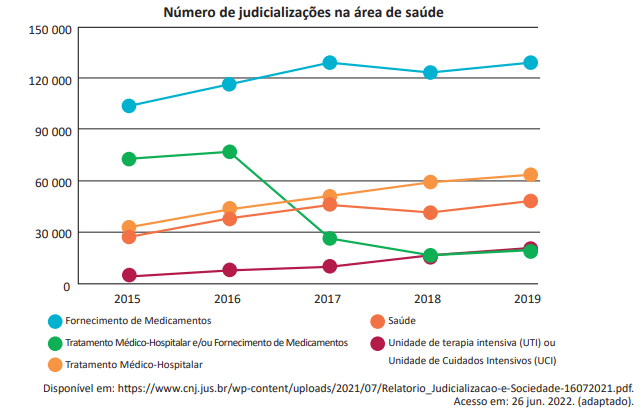
Considerando o texto e o gráfico apresentados, avalie as asserções a seguir e a relação proposta entre elas.
I. O principal papel do Judiciário, na administração da saúde, é a alocação dos recursos públicos, contribuindo para que os municípios possam prestar tratamentos médico-hospitalares e fornecer medicamentos à população carente.
PORQUE
II. A saúde é direito de todos e dever do Estado, garantida mediante políticas sociais e econômicas que visem à redução do risco de doença e de outros agravos e ao acesso universal e igualitário às ações e serviços para sua promoção, proteção e recuperação.
A respeito dessas asserções, assinale a opção correta.
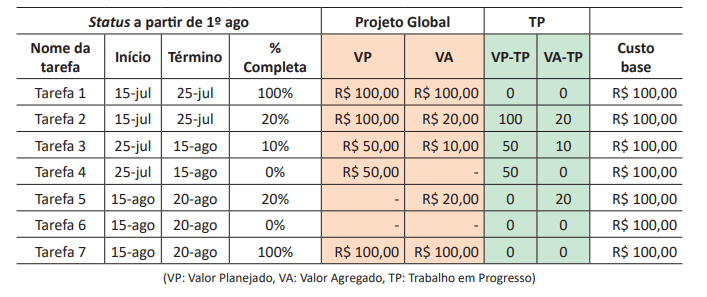
Considerando que o Índice de Desempenho de Prazos (IDP) é a medida do quão perto da linha de base do cronograma está o progresso do trabalho, nesta situação, o IDP global do projeto é